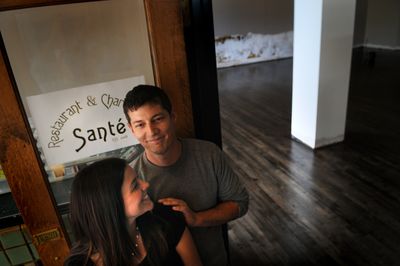Home-grown homecoming
Rising-star chef returns to Spokane to open Santé

Crowds around Auntie’s Bookstore in downtown Spokane on Saturday are bound to buzz about something other than this weekend’s centennial celebration for the historic Liberty Building.
If everything goes according to plan, they should at least get to peek in at the progress of the city’s latest culinary acquisition, Santé Restaurant and Charcuterie, 404 W. Main Ave., in the former space of the Liberty Cafe.
The restaurant’s been stirring up murmurs ever since somebody plastered brown paper over the windows earlier this summer, posting salivating teasers advertising a restaurant with house-cured meats and sausages – that’s the charcuterie part – and promising a new future for the stellar space other than the obligatory bookstore cafe.
That something – an upscale eatery using Northwest ingredients prepared from scratch with European flair – is the brainchild of Spokane couple Jeremy and Kate Hansen.
Like many Spokane-area chefs, Jeremy Hansen spent his early years cutting his teeth in the local scene, working at the original downtown Mustard Seed and then at Fugazzi, under then-head chef Jason Rex, who now runs the kitchen at his own restaurant, Scratch.
Then, as so many stories go, Hansen moved away. First to Portland, to study at Le Cordon Bleu’s Western Culinary Institute and spend some time in that city’s kitchens (including Christopher Israel’s restaurant, 23hoyt) and then to New York to gain some more experience before Spokane’s gravity brought him back into the Inland orbit.
It was during his time in Portland under Chef Israel that Hansen learned a lesson about the new school of American cuisine, and about himself, that started on the path to charcuterie.
The moment was a simple one: Hansen asked Israel if the restaurant had purchased a prepped ingredient that was used in a recipe.
“He looked at me like, are you kidding? Of course we didn’t buy it. We made it,” Hansen said.
It’s this from-scratch approach – a lot of upscale restaurants nowadays even mix their own half-and-half – that brought Hansen to the decision to take it a step further and open a restaurant that makes its own meats from whole animals.
“I’ve worked in a lot of restaurants with different cuisine styles, and this is a style I haven’t really worked with a lot,” Hansen said. “So I just got really interested in it, and playing with meats, breaking down hogs.
“It’s just the flavor, and the satisfaction that you have from start to finish, with using the whole pig. Everything from seeing it live, then coming up a week, two weeks later with Canadian bacon or a sausage or whatever. And the flavors that you get from the brines, and the salts, and the cures and the aging. I think it’s just awesome.”
Because of the nature of the art, the Hansens won’t immediately be able to offer the full range of meats they eventually plan to use in dishes at the restaurant after its target opening in mid-October.
It’ll be a long wait for prosciutto, for example, because the curing and aging process takes anywhere from six months to two years, depending on where it’s from and who’s aging it.
For the time being, Santé will offer house-cured items that have short turnaround time periods, such as gravlax (aka lox, or cured salmon), which only takes a few days to finish.
When it comes to items that take longer to finish, Hansen plans to use high-end stand-ins, such as Prosciutto di Parma, which comes from Parma, Italy, and is considered by many to be the pinnacle of prosciutto.
If you’re wiping the drool off your chin thinking about house-made prosciutto, bratwurst and mortadella, you’re not alone.
Another part of Hansen’s business plan is to sell his meats to other restaurants in the area, letting his personal touches permeate local kitchens (Hansen has yet to decide whether public retail sales are in Santé’s future).
Hansen’s early mentor, Jason Rex, looks forward to checking out Santé’s products, to consider using them at Scratch.
Talk about full-circle.
It’s a collaboration that’s bound to work, because, as is obvious from his restaurant’s name, Rex shares in the philosophy as Hansen puts it:
“A restaurant shouldn’t be a place where you just buy all these separate (pre-made) products and put them together,” he said. “Unfortunately, that’s what a lot of places do.”